|
|
|||
|
(Back to Preceding Week; on to Next Week) |
|
BLUE-WINGED WARBLER One advantage of using pull-string or electronic traps to capture birds is that we can be selective about catching specific individuals. This is especially helpful April through October when any given resident Ruby-throated Hummingbird may enter our traps over and over and over again--literally thousands of times during the season per bird.
All text & photos © Hilton Pond Center Vermivora warblers are smallish birds about 4" to 4.5" long; in addition to Blue-winged (above), in the eastern U.S. the genus includes Golden-winged (with which Blue-wings hybridize to produce Brewster's and Lawrence's), Tennessee, Orange-crowned, Nashville, and the now-extinct Bachman's Warbler. Three more Vermivora species occur exclusively in the West: Virginia's, Colima, and Lucy's Warblers. Perhaps the most striking characteristic of any Vermivora warbler is its sharply pointed bill--illustrated above--a tool for gleaning and grabbing small insects, spiders, and other invertebrates. Curiously, the genus name means "worm-eater," even though worms do not make up much, if any, of a Blue-winged Warbler's diet.
The Blue-winged Warbler's common name is nicely descriptive; aside from the yellow or yellow-olive of its head and body, the first thing once notices about this Neotropical migrant is its slate-blue wings (above), with a slate-blue tail to match.
Another noticeable aspect of the wings is that the primary feather coverts and lesser coverts have pale tips, giving rise to two white wing bars. These are whiter in adults and wider in males. A more definite way to determine sex in some bird species is by measuring the wing chord; several sources report for Blue-wings this length ranges from 54-61mm in females and 55-68mm in males. Unfortunately, our bird measured 59mm--within the overlap between sexes. Nonetheless, indistinct wing bars and a less-than-prominent black eye line and darkish crown leads us to believe our capture was a juvenile female that hatched out sometime in the summer of 2008.
Many Wood Warblers that sport wing bars also have tail spots, and our Blue-wing was no exception. The photo above reveals almost the entire inner web of the outermost rectrix (tail feather) is white, as are the tips of the second and third rectrices. Tails spots not only help a birder identify warblers, they also likely aid in species identification among the birds themselves. Some ornithologists suspect warbler tail spots--which are alternately revealed and hidden during foraging--may startle insects and make them more easily seen and taken by the bird.
For many observers, their only view of Blue-winged Warblers comes when the birds are feeding overhead; this leads to "warbler neck," an affliction that comes from tilting one's head back 'way too far for 'way too long a time in during attempts to identify warblers 'way to far up in the canopy. (One tried-and-true remedy for this condition is to do your warbler watching only while reclined fully in a backyard chaise lounge.) Fortunately, the Blue-winged Warbler tends to hang out closer to the ground, plus it has a ventral characteristic that helps with identification: Its otherwise yellow underparts are white in the region of undertail coverts that overlap the base of the tail (above).
In combination with the characteristics above, a final field mark useful in identifying Blue-winged Warblers is their leg and foot color. The legs--which are actually pale pinkish blue-gray (above)--appear much lighter than the black legs of some warblers. And, up close, we can see the toes and claws are pale yellow, especially in younger birds. Although the Blue-wing's common name is apt, its scientific name, V. pinus, is quite misleading; this is NOT a bird of the piney woods. Instead it breeds in second-growth habitat in the Northeast and Central states, building its nest near or on the ground at the bases of ferns, forbs, and shrubs. The species is one of a few warblers that benefit from clear-cutting of forests; Blue-wing fecundity is diminished because they are heavily parasitized by Brown-headed Cowbirds, but their greatest threat is probably residential and commercial development in the U.S. and deforestation of wintering grounds in the deciduous and evergreen forests of eastern and Central Mexico. In Spanish the Blue-winged Warbler is called Chipe de Ala Azul. We know of no confirmed breeding records of Blue-winged Warblers for South Carolina, although there are records of singing summer males and they do breed in adjoining North Carolina and Georgia. At Hilton Pond Center we see Blue-wings only during spring and autumn migration when the birds go to and from the tropics.
Incidentally, we caught our most recent Blue-winged Warbler on 17 August 2008--earlier by two days than South Carolina's previous fall migration record. For the next few months we'll be hoping for another Blue-wing or two--we've banded just 23 during 26 years at Hilton Pond Center--and if we're lucky next spring we'll even catch a brightly plumaged adult male like the one above netted locally in April 2003.
All text & photos © Hilton Pond Center
Comments or questions about this week's installment?
Thanks to the following fine folks for recent gifts in support of Hilton Pond Center for Piedmont Natural History and/or Operation RubyThroat: The Hummingbird Project. Your tax-deductible contributions allow us to continue writing, photographing, and sharing "This Week at Hilton Pond." (Please see Support if you'd like to make a gift of your own.)
"This Week at Hilton Pond" is written & photographed You may wish to consult our Index of all nature topics covered since February 2000. You can also use our on-line Hilton Pond Search Engine at the bottom of this page. For a free, non-fattening, on-line subscription to |
|
Make direct donations on-line via
Network for Good: |
|
|
Use your PayPal account
to make direct donations: |
|
|
If you like to shop on-line, you please become a member of iGive, through which more than 700 on-line stores from Barnes & Noble to Lands' End will donate a percentage of your purchase price in support of Hilton Pond Center and Operation RubyThroat. For every new member who signs up and makes an on-line purchase iGive will donate an ADDITIONAL $5 to the Center. Please sign up by going to the iGive Web site; more than 150 members have signed up to help. It's a painless, important way for YOU to support our work in conservation, education, and research. |
|
| The highly coveted Operation RubyThroat T-shirt (four-color silk-screened) is made of top-quality 100% white cotton. It highlights the Operation RubyThroat logo on the front and the project's Web address (www.rubythroat.org) across the back.
Now you can wear this unique shirt AND help support Operation RubyThroat: The Hummingbird Project and Hilton Pond Center. Be sure to let us know your mailing address and adult shirt size: Small (suitable for children), Medium, Large, X-Large, or XX-Large. These quality shirts don't shrink! Price ($21.50) includes U.S. shipping. A major gift of $1,000 gets you two Special Edition T-shirts with "Major Donor" on the sleeve. |
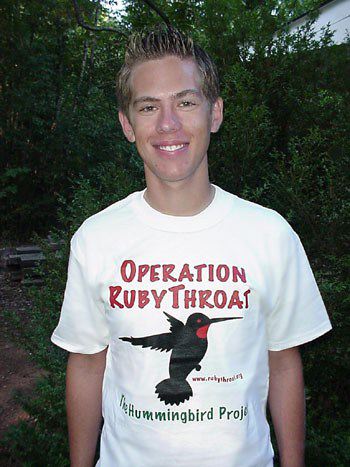
Need a Special Gift for a Want to make a If so, why not use our new handy-dandy on-line Google Checkout below to place your secure credit card order or become a Major Donor today? |
|
|
|
|
SPECIES BANDED THIS WEEK: * = New species for 2008 WEEKLY BANDING TOTAL 10 species 43 individuals YEARLY BANDING TOTAL (2008) 49 species 1,203 individuals 105 Ruby-throated Hummingbirds 27-YEAR BANDING GRAND TOTAL (since 28 June 1982) 124 species 51,376 individuals NOTABLE RECAPTURES THIS WEEK (with original banding date, sex, and current age) 2008 Ruby-throated Hummingbird returns from past years--38 Ruby-throated Hummingbird (3) American Goldfinch (1) Northern Cardinal (2) Downy Woodpecker (1) Carolina Wren (1)
|
OTHER NATURE NOTES OF INTEREST --The drought continued at Hilton Pond Center during the third week of August, so much so that the raft that normally floats at the end of the dock is now sitting on pond bottom. That means the water level is four feet below full pond--not a good sign when the hottest, evaporation-prone days of summer may still be ahead. The water level continues to drop at a rate of almost an inch per day; this exposes an additional 2-3" of mud bank every 24 hours. --A Ruby-throated Hummingbird trapped on 17 Aug had been banded at Hilton Pond Center as an adult female on 8 Jun 2005, making her now an after fourth year bird. The unusual thing was she's one of a very few locally banded RTHU that skipped two years before being recaptured for the first time. We wonder where she's been the past two summers.
|
|
|
|
(Back to Preceding Week; on to Next Week) Up to Top of Page Back to This Week at Hilton Pond Center Current Weather Conditions at Hilton Pond Center |
 You can also post questions for The Piedmont Naturalist |
Join the |
Search Engine for |
|
|
Orbitz Hotels

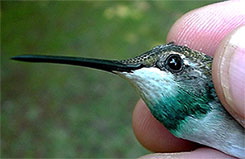 To avoid unnecessary recaptures we color mark all our Hilton Pond ruby-throats with green dye (right); Costa Rica birds get a necklace of blue. Our other primary method of catching birds--42-foot-long mist nets that are nearly invisible when hung between two ten-foot-tall poles--bring a different dimension to bird capture; the nets are non-selective, so we never know what we might catch on any given day. Thus, we're always delighted by what we snare, and sometimes we're even surprised. Such was the case this week at Hilton Pond Center when we deployed a net near our old farmhouse to capture hummingbirds but instead caught a somewhat larger bird of a different color that we seldom see locally: An early fall migrant Blue-winged Warbler, Vermivora pinus.
To avoid unnecessary recaptures we color mark all our Hilton Pond ruby-throats with green dye (right); Costa Rica birds get a necklace of blue. Our other primary method of catching birds--42-foot-long mist nets that are nearly invisible when hung between two ten-foot-tall poles--bring a different dimension to bird capture; the nets are non-selective, so we never know what we might catch on any given day. Thus, we're always delighted by what we snare, and sometimes we're even surprised. Such was the case this week at Hilton Pond Center when we deployed a net near our old farmhouse to capture hummingbirds but instead caught a somewhat larger bird of a different color that we seldom see locally: An early fall migrant Blue-winged Warbler, Vermivora pinus. 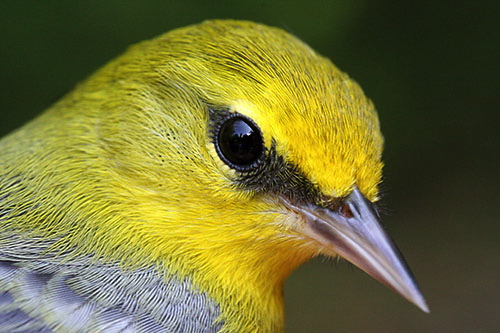

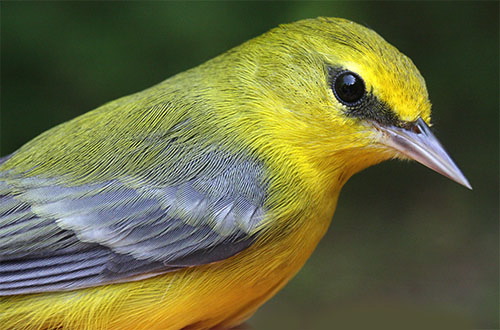
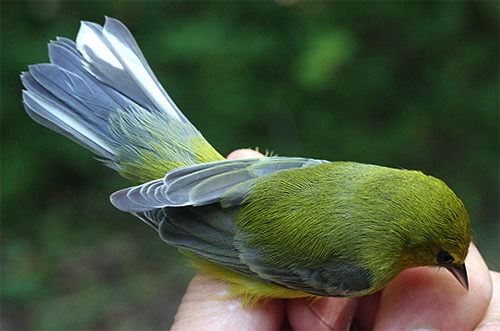
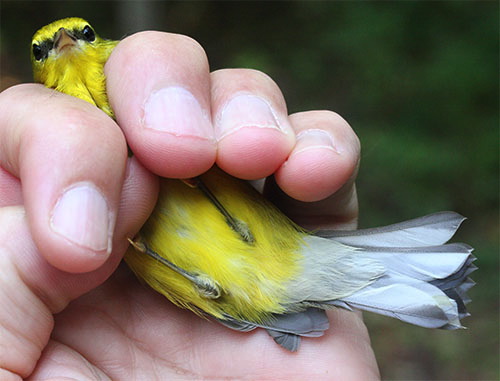
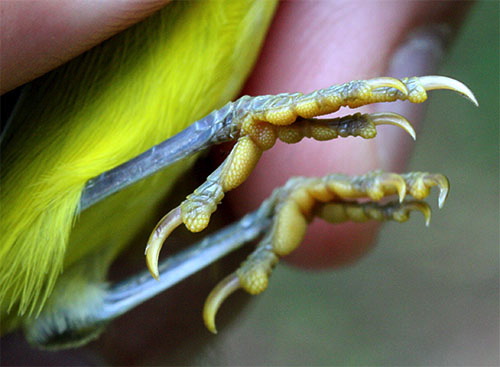



 Please report your
Please report your